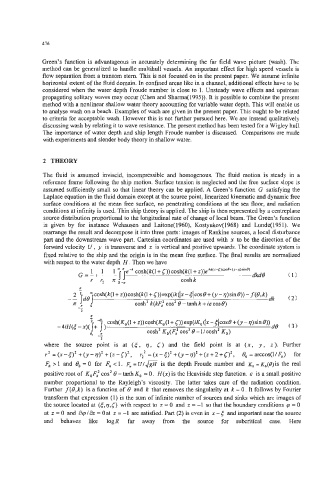Page 501 - Practical Design Ships and Floating Structures
P. 501
416
Green's function is advantageous in accurately determining the far field wave picture (wash). The
method can be generalized to handle multihull vessels. An important effect for high speed vessels is
flow separation from a transom stem. This is not focused on in the present paper. We assume infinite
horizontal extent of the fluid domain. In confined areas like in a channel, additional effects have to be
considered when the water depth Froude number is close to 1. Unsteady wave effects and upstream
propagzting solitary waves may occur (Chen and Sharma(1995)). It is possible to combine the present
method with a nonlinear shallow water theory accounting for variable water depth. This will enable us
to analyse wash on a beach. Examples of wash are given in the present paper. This ought to be related
to criteria for acceptable wash. However this is not further pursued here. We are instead qualitatively
discussing wash by relating it to wave resistance. The present method has been tested for a Wigley hull.
The importance of water depth and ship length Froude number is discussed. Comparisons are made
with experiments and slender body theory in shallow water.
2 THEORY
The fluid is assumed inviscid, incompressible and homogenous. The fluid motion is steady in a
reference frame following the ship motion. Surface tension is neglected and the free surface slope is
assumed sufficiently small so that linear theory can be applied. A Green's function G satisfying the
Laplace equation in the fluid domain except at the source point, linearized kinematic and dynamic free
surface conditions at the mean free surface, no penetrating conditions at the sea floor, and radiation
conditions at infinity is used. Thin ship theory is applied. The ship is then represented by a centreplane
source distribution proportional to the longitudinal rate of change of local beam. The Green's function
is given by for instance Wehausen and Laitone(l960), Kostyukov(l968) and Lunde( 195 1). We
rearrange the result and decompose it into three parts: images of Rankine sources, a local disturbance
part and the downstream wave part. Cartesian coordinates are used with x to be the direction of the
forward velocity U , y is transverse and z is vertical and positive upwards. The coordinate system is
fixed relative to the ship and the origin is in the mean free surface. The final results are normalized
with respect to the water depth H . Then we have
-
a cosh(k(1 + z))cosh(k(l + <))exp(ik(lx - 61cosB + (y - 7)sinB)) - f(8,k)
-2 ]dI9j dk (2)
__
IC, 0 cosh2 k(kFi cos2 I9 - tanh k + iecosI9)
2
X
cosh(Ko(l + z))cosh(K,,(l + C))exp(iK, dx - +os0 + (y - r,-)sin 8))
- 4wr - XI( I+ 1 dI9 (3)
e,, -1 cosh' Ko(Fi cos' B-1/cosh2 KO)
2
where the source point is at (5, 7, <) and the field point is at (x, y, z). Further
o0
r2 =(~-5)~+(y-7)~+(z-r)~, =(~-5)*+(y-f7)~+(~+2+r)~, =arccos(l/F,) for
r2*
F,, > 1 and 6Jo = 0 for & < 1. F,, = U/,@? is the depth Froude number and K~ = K,(e)is the real
positive root of KoF: cos2 B - tanh K, = 0. H(x) is the Heaviside step function. E is a small positive
number proportional to the Rayleigh's viscosity. The latter takes care of the radiation condition.
Further f(0,k) is a function of B and k that removes the singularity at k = 0. It follows by Fourier
transform that expression (1) is the sum of infinite number of sources and sinks which are images of
the source located at (e,~,<) with respect to z = 0 and z = -1 so that the boundary conditions = 0
at z = 0 and &p/& = Oat z = -1 are satisfied. Part (2) is even in x -4 and important near the source
and behaves like logR far away from the source for subcritical case. Here

